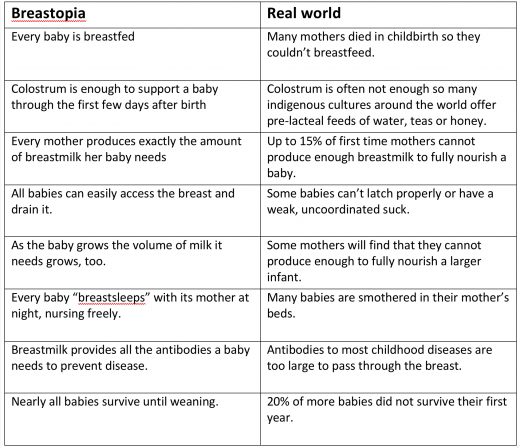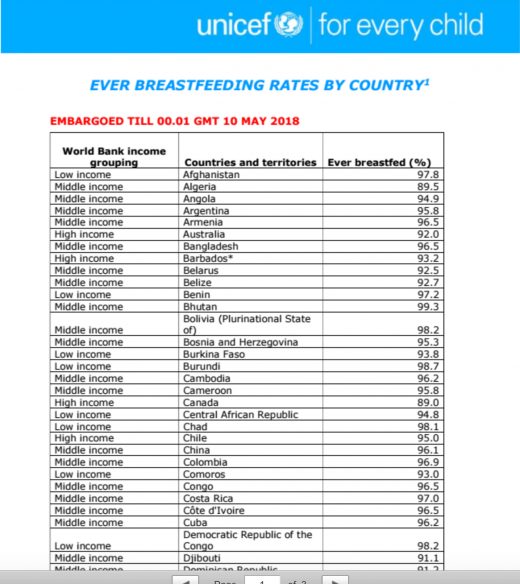
It’s the ur-myth of lactivism, the belief that we came from Breastopia and we should return to Breastopia.
There’s just one problem: Breastopia never existed and frantic efforts to “reclaim” it are harming babies and mothers.
To understand why it helps to compare Breastopia to the natural world. That’s why I created the handy chart below.

In Breastopia every baby is breastfed, but in the real world many mothers died in childbirth and therefore couldn’t breastfeed. Many of these babies died.
[pullquote align=”right” cite=”” link=”” color=”” class=”” size=””]Breastopia never existed and frantic efforts to “reclaim” it are harming babies and mothers.[/pullquote]
In Breastopia colostrum is enough to support a baby through the first days after birth. In the real world many babies suffer dehydration, hypoglycemia and severe jaundice as a result of insufficient breastmilk. That’s probably the reason why indigenous cultures around the world offer pre-lacteal feeds. Many of these babies died.
In Breastopia a mother’s breastmilk production completely matches her baby’s needs. In the real world up to 15% of first time mothers don’t produce enough breastmilk to fully nourish an infant. Many of these babies died.
In Breastopia all babies can easily latch and can effectively suck. In the real world some babies can’t latch properly or have a weak, uncoordinated suck. Many of these babies died.
In Breastopia every baby “breastsleeps” with its mother, nursing freely throughout the night. In the real world many babies are smothered their mothers beds.
In Breastopia nearly all babies survive until weaning. In the real world anywhere from 20-40% babies or more do not survive their first year.
The clever among you are probably sensing a theme: breastfeeding, like any natural process, is far from perfect. As a result there are high rates of infant wastage. In other words, many babies naturally die in infancy.
Despite the fact that Breastopia literally never existed, many lactation professionals insists that we can and should return to it.
Consider the latest data dump on breastfeeding released by UNICEF.
According to a CNN article entitled The countries where 1 in 5 children are never breastfed:
A new UNICEF report released Wednesday that ranks countries by breastfeeding rates shows that in high-income countries, more than one in five babies is never breastfed, whereas in low- and middle-income countries, one in 25 babies is never breastfed…
“The data and the analyses are a confirmation of a trend that we have seen for a number of years now,” said Victor Aguayo, UNICEF’s chief of nutrition, who was involved in the report’s policy analysis.
Aguayo bemoans the fact that many children are never breastfed and insists that we must make breastfeeding the norm.
“In higher-income countries, we see that the proportion of children who have never been breastfed is significantly higher than the number of children in low- and middle-income countries. That is a fact,” he said. “We need to create environments — including in the US — that make breastfeeding the norm.”
It’s almost as if he thinks breastfeeding makes infants healthier and saves lives. But that’s NOT what the data shows.

You can examine the full chart of international breastfeeding rates embedded in the article.
Let’s look at a few representative countries.
Afghanistan has a breastfeeding rate of 97.8%. It also has an astronomical infant mortality rate of 102.9/1000.
Burundi has an even higher breastfeeding rate of 98.8%. It’s infant mortality rate is also appalling at 81.1/1000.
How about the countries that UNICEF chastises for low breastfeeding rates like the US and France?
The US has a breastfeeding rate of 74.4% and an infant mortality rate of 5.87/1000.
France has an even lower breastfeeding rate of 63% and an even lower infant mortality rate of 3.2/1000.
Are you noticing a trend? That’s right, breastfeeding rate has NOTHING to do with infant mortality.
Moreover, as far as I know, there is no evidence that increasing the breastfeeding rate in a country leads to any measurable benefit in reduced infant mortality. The only exception to this is the case of very premature babies who have a reduced incidence of necrotizing enterocolitis when fed breastmilk.
None of this should be remotely surprising. Breastfeeding was far from perfect in nature and it is far from perfect now. Indeed, as I’ve written many times in past, the benefits of breastfeeding in countries with clean water are trivial, and not particularly compelling elsewhere, either.
So what’s driving the relentless pressure to increase breastfeeding rates? It obviously isn’t scientific evidence since no one can demonstrate any real world benefit to increased breastfeeding rates for term babies.
What’s driving it is the lactivist belief in Breastopia — the belief that Breastopia existed in the past and we could return to Breastopia in the future if we just offered greater support pressure to breastfeed. Lactivists are longing for a past that literally never existed. By relentlessly seeking to recapture it they are coming up against the real world limitations of breastfeeding … and seriously harming babies and mothers as a result.

